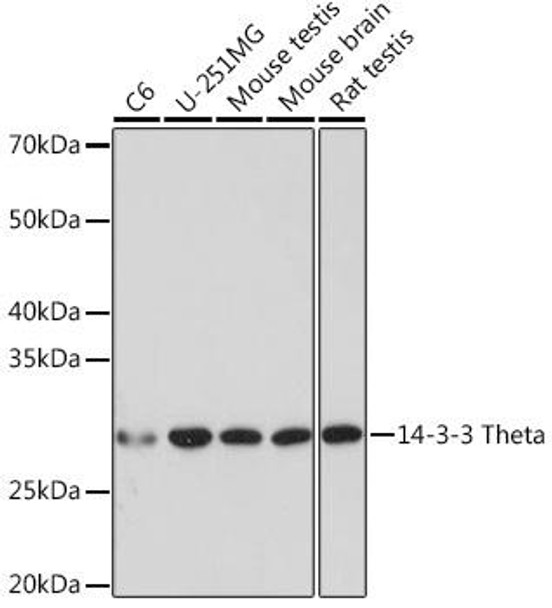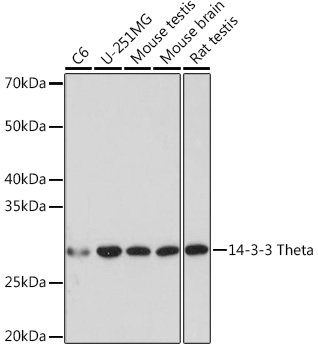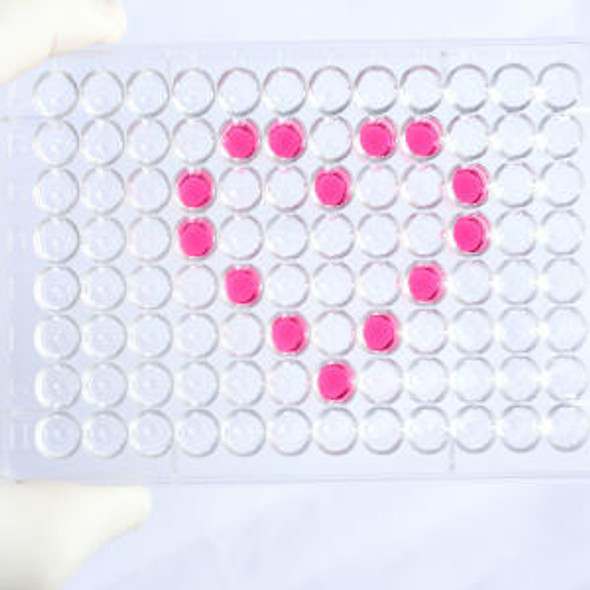Anti-14-3-3 Theta Antibody (CAB8936)
- SKU:
- CAB8936
- Product type:
- Antibody
- Reactivity:
- Human
- Mouse
- Rat
- Host Species:
- Rabbit
- Isotype:
- IgG
- Antibody Type:
- Monoclonal Antibody
- Research Area:
- Cell Biology
Frequently bought together:
Description
| Antibody Name: | Anti-14-3-3 Theta Antibody |
| Antibody SKU: | CAB8936 |
| Antibody Size: | 20uL, 50uL, 100uL |
| Application: | WB IF |
| Reactivity: | Human, Mouse, Rat |
| Host Species: | Rabbit |
| Immunogen: | A synthesized peptide derived from human 14-3-3 Theta |
| Application: | WB IF |
| Recommended Dilution: | WB 1:500 - 1:2000 IF 1:50 - 1:200 |
| Reactivity: | Human, Mouse, Rat |
| Positive Samples: | C6, U-251MG, Mouse testis, Mouse brain, Rat testis |
| Immunogen: | A synthesized peptide derived from human 14-3-3 Theta |
| Purification Method: | Affinity purification |
| Storage Buffer: | Store at -20°C. Avoid freeze / thaw cycles. Buffer: PBS with 0.02% sodium azide, 0.05% BSA, 50% glycerol, pH7.3. |
| Isotype: | IgG |
| Sequence: | Email for sequence |
| Gene ID: | 10971 |
| Uniprot: | P27348 |
| Cellular Location: | |
| Calculated MW: | 28kDa |
| Observed MW: | 28KDa |
| Synonyms: | 14-3-3, 1C5, HS1 |
| Background: | This gene product belongs to the 14-3-3 family of proteins which mediate signal transduction by binding to phosphoserine-containing proteins. This highly conserved protein family is found in both plants and mammals, and this protein is 99% identical to the mouse and rat orthologs. This gene is upregulated in patients with amyotrophic lateral sclerosis. It contains in its 5' UTR a 6 bp tandem repeat sequence which is polymorphic, however, there is no correlation between the repeat number and the disease. [provided by RefSeq, Jul 2008] |
| UniProt Protein Function: | 14-3-3 theta: a protein of the 14-3-3 family of proteins which mediate signal transduction by binding to phosphoserine-containing proteins. A multifunctional regulator of the cell signaling processes. Associates with c-BCR and BCR-Abl. |
| UniProt Protein Details: | Protein type:Adaptor/scaffold Chromosomal Location of Human Ortholog: 2p25.1 Cellular Component: cytoplasm; cytoplasmic vesicle membrane; cytosol; focal adhesion; membrane; mitochondrion; protein complex Molecular Function:protein binding; protein C-terminus binding; protein domain specific binding; protein N-terminus binding Biological Process: apoptosis; gene expression; negative regulation of transcription, DNA-dependent; programmed cell death; small GTPase mediated signal transduction; substantia nigra development; transcription initiation from RNA polymerase II promoter |
| NCBI Summary: | This gene product belongs to the 14-3-3 family of proteins which mediate signal transduction by binding to phosphoserine-containing proteins. This highly conserved protein family is found in both plants and mammals, and this protein is 99% identical to the mouse and rat orthologs. This gene is upregulated in patients with amyotrophic lateral sclerosis. It contains in its 5' UTR a 6 bp tandem repeat sequence which is polymorphic, however, there is no correlation between the repeat number and the disease. [provided by RefSeq, Jul 2008] |
| UniProt Code: | P27348 |
| NCBI GenInfo Identifier: | 112690 |
| NCBI Gene ID: | 10971 |
| NCBI Accession: | P27348.1 |
| UniProt Secondary Accession: | P27348,Q567U5, Q5TZU8, Q9UP48, D6W4Z5, |
| UniProt Related Accession: | P27348 |
| Molecular Weight: | |
| NCBI Full Name: | 14-3-3 protein theta |
| NCBI Synonym Full Names: | tyrosine 3-monooxygenase/tryptophan 5-monooxygenase activation protein theta |
| NCBI Official Symbol: | YWHAQ |
| NCBI Official Synonym Symbols: | 1C5; HS1; 14-3-3 |
| NCBI Protein Information: | 14-3-3 protein theta |
| UniProt Protein Name: | 14-3-3 protein theta |
| UniProt Synonym Protein Names: | 14-3-3 protein T-cell; 14-3-3 protein tau; Protein HS1 |
| Protein Family: | 14-3-3 protein |
| UniProt Gene Name: | YWHAQ |
| UniProt Entry Name: | 1433T_HUMAN |











